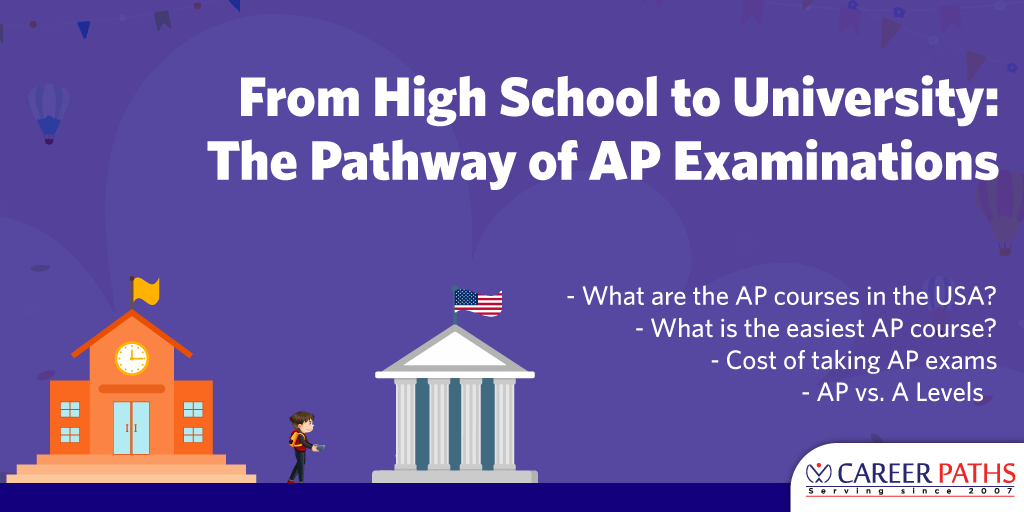AP, or Advanced Placement, is a program run by the College Board that offers college-level education and testing to high school students in the United States and Canada. By performing well on these exams, students may receive advanced placement or college credit from colleges and universities in the US and other countries. The College Board works with a team of experts and higher education educators to design the AP curriculum for each subject.
For a high school course to be deemed as an Advanced Placement (AP) course, it must undergo evaluation and receive authorization from the College Board. This examination confirms that the course’s curriculum aligns with the AP guidelines laid out in the Board’s Course and Examination Description. Upon approval, the high school is permitted to use the AP label, and the course will be publicly displayed on the AP Course Ledger.
What are the AP courses in the USA?
As of now, the AP Program provides 37 different courses and exams.
They are listed below:
| Art and Design (formerly Studio Art): 2-D Design
|
Environmental Science | Physics 1: Algebra-Based |
|---|---|---|
| Art and Design (formerly Studio Art): 3-D Design
|
European History | Physics 2: Algebra-Based |
| Art and Design (formerly Studio Art): Drawing | French Language and Culture
|
Physics C: Electricity and Magnetism |
| Art History
|
German Language and Culture
|
Physics C: Mechanics |
| Biology | Government and Politics (Comparative) | Psychology |
| Calculus AB
|
Government and Politics (US) | Research
|
| Calculus BC
|
Human Geography | Spanish Literature and Culture |
| Chemistry | Italian Language and Culture | Spanish Language and Culture |
| Chinese Language and Culture
|
Japanese Language and Culture | Seminar |
| Computer Science A | Latin | Statistics |
| Computer Science Principles
|
Macroeconomics | US History |
| English Language and Composition
|
Microeconomics
|
World History: Modern
|
| English Literature and Composition
|
Music Theory |
What is the easiest AP course?
Universities in the US and Canada often offer college credit to students who receive a grade of 3 or higher on their AP exams. The scores for AP examinations are rated on a numerical scale from 1 to 5, with 5 representing the highest level of mastery and 1 representing a level where no recommendation is made.
The grades are determined as follows:
5- Extremely Well Qualified
4- Well Qualified
3- Qualified
2- Possibly Qualified
1- No Recommendation
Before we get to the easiest AP courses, let’s look at the most popular AP courses.
| Exam Name | No. of Students Taking (2022) |
|---|---|
| English Language and Composition | 520,771 |
| United States History | 456,520 |
| English Literature and Composition | 339,401 |
| World History | 314,716 |
| Gov. and Politics – United States | 298,118 |
| Psychology | 292,501 |
| Calculus AB | 268,352 |
| Biology | 237,338 |
| Human Geography | 221,815 |
| Statistics | 216,968 |
| Environmental Science | 179,957 |
The easiest AP courses were determined based on the AP Test Passing Rates from 2022 on prepscholar.com. The following is a list of the top 10 easiest AP courses.
| Exam Name | Passing Rate (3+) |
|---|---|
| Art and Design: Drawing | 88% |
| Chinese Language and Culture | 87% |
| Art and Design: 2-D Design | 87% |
| Seminar | 83% |
| Research | 83% |
| Spanish Language and Culture | 82% |
| English Literature and Composition | 78% |
| Calculus BC | 77% |
| Japanese Language and Culture | 75% |
| Art and Design: 3-D Design | 74% |
Cost of taking AP exams
As of the 2023 testing year, the fee for each exam is $97*, though some local or state programs may offer financial support. Eligible students can access financial aid and receive a reduction of $35 per exam from the College Board and an additional $9 discount per exam from the school. The cost of the exam may be further lowered based on the state. Out of the $97 fee, $8 is set aside to cover the administrative costs of the test and some schools may choose to decrease this fee to reduce the overall cost for the student.
*As of 2023, the fee per exam for schools in the United States, its territories, Canada, and schools in the Department of Defense Education Activity is $97. The fee for schools located elsewhere is $127, although it’s worth mentioning that fees for exams taken at College Board-authorized testing centers located outside the US may vary. The fee for AP Capstone™ exams (AP Seminar and Research) is $145 per exam.
For more information regarding costs, click here.
AP vs. A Levels
The process of gaining admission to a university has become highly competitive and top schools are searching for students who show they are capable of handling an international academic curriculum. In light of this, it can be difficult to determine which classes to take in order to attend your desired university. To assist with this decision, there are several factors to consider. Here, we provide a comparison between two of the most frequently studied international curricula, A Levels and Advanced Placement (AP) courses.
The A-levels was created by the government of the United Kingdom and mainly comprises British content, modified to cater to a global audience. On the other hand, the American-based high school curriculum, AP courses, are developed by the College Board in the United States and mostly contain American material. In the twelfth academic year, students proceed to advanced level (A-Level) studies, which are further divided into two segments: the AS Level, known as the “Advanced Subsidiary,” is typically undertaken in year twelve, and the A2 Level, which is usually completed in the thirteenth year. Conventionally, students study 4-5 subjects at the AS Level and then continue with 3-4 of those subjects at the A2 Level.
The A-Levels form a complete high school curriculum, while the AP courses are supplementary college-level classes provided in American high schools or through an online high school program. Many students choose to self-study these year-long subjects, along with their regular coursework, as a demonstration of academic rigor. The International GCSEs are exclusively evaluated through a series of end-of-course exams, offering students the option of taking them on two different dates throughout the year, thereby allowing for scheduling flexibility. This also provides students the chance to retake exams if they believe their performance was insufficient. On the other hand, APs are evaluated through a single standardized end-of-year exam that is solely based on external assessment.
Which of the two programs, A-Levels or AP, is most widely acknowledged across the globe?
The distinction of global recognition is often attributed to A Levels, as they are widely recognized and utilized in a vast number of institutions. Over 10,000 schools and over a million students in 160 countries study International GCSEs and A Levels, and these qualifications are acknowledged by over 1,400 universities worldwide.
In the United Kingdom, all universities recognize A Level credentials, as do 600 universities in the United States, including Ivy League schools, and universities in countries such as Canada, Australia, Singapore, South Africa, Germany, and the Netherlands. On the other hand, AP courses are primarily offered by US curriculum schools around the world.
The program that aligns with your individual preferences and academic style should be your main choice. If you desire a curriculum with a broad scope that allows you to study multiple disciplines and offers ample exam scheduling options, then A-levels are ideal for you. Conversely, if you seek a meticulous curriculum and college-level courses, then Advanced Placement (AP) may be the optimal choice for you.











